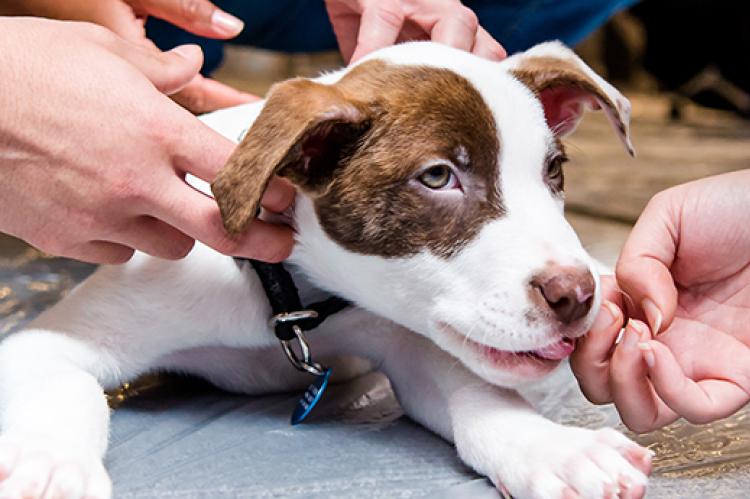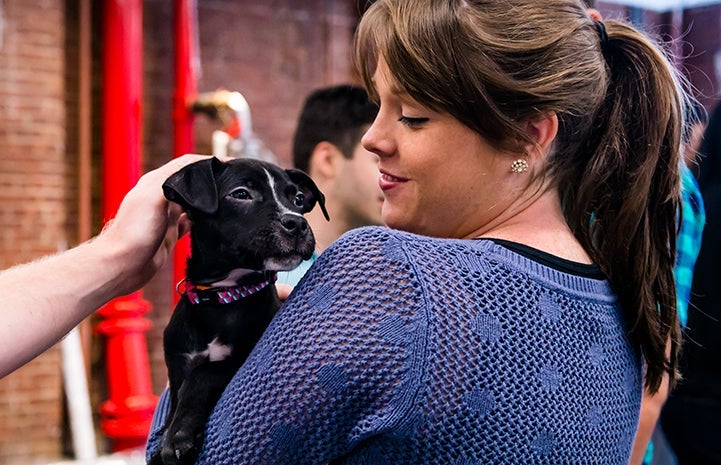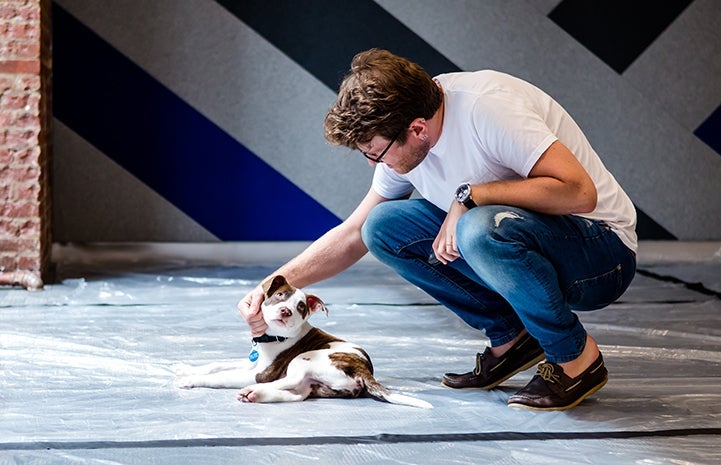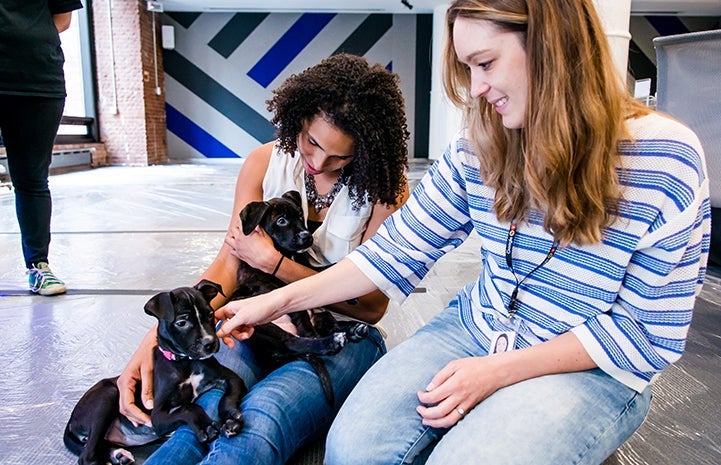Puppy Socialization: How to Socialize a Puppy to People, Dogs

The primary puppy socialization period — the period of a puppy’s life when it is most important to expose them to people and other dogs — is between 3 and 16 weeks old. If a puppy is exhibiting fearful behaviors such as growling, snapping, or biting, it’s important to work them through this with a positive socialization plan while the puppy is still young. An adult dog who remains fearful due to lack of socialization can be helped through systematic desensitization and counterconditioning, but the process can be lengthy. That’s why it’s so important to socialize dogs while they are young.
As you’re working with your puppy, keep in mind that socialization is only one factor. Some dogs are genetically predisposed to exhibit fear-based behaviors or have other behavior concerns.
Follow this puppy socialization guide for tips to promote confidence and good manners in puppies when they’re around people, other dogs, and more.

How to socialize a puppy: The basics
Expose puppies to a variety of sounds, scents, surfaces, and objects. The idea is to help puppies become comfortable with typical experiences they will have in their lives as adult dogs.
While socializing, watch the pup’s body language to determine whether they’re feeling safe and happy during these interactions. You’ll want to let the puppy take things at their own speed; don’t force them into situations in which they appear to be uncomfortable. Do not flood your puppy either during this process; keep interactions positive and short, if needed.
As you introduce puppies to new experiences, feed them special treats and give lots of praise. Discovering new things should be fun for puppies.
When can puppies be around other dogs?
Beginning at around 3 to 8 weeks old, puppies learn to feel safe and happy around other dogs. Puppies between 3 and 8 weeks old should be kept with at least one other puppy and, ideally, with their mother if you are able. However, if the mom of the puppy is not providing proper care, then they can be separated.
Orphaned puppies should be isolated from all other puppies and adult dogs with compromised immune systems for a 14-day quarantine period and then put in a group of puppies of similar size, age, and vaccination status if possible. During this time, maintain socialization with people.
Once they are 8 weeks old and after their second set of parvo/distemper vaccinations, puppies should receive exposure to socially appropriate adult dogs and other puppies of the same vaccination status and ideally of similar ages. There are puppy groups and classes that can provide this socialization.
In all cases, interrupt play if a dog appears to be stressed. It’s crucial you keep dog interactions as positive as possible during this time; do not introduce your puppy to dogs who do not enjoy interaction with other dogs. Also, ensure that you are allowing the adult dogs to give appropriate and necessary feedback to the puppies, such as correction for biting. This will help them become socially appropriate adults.
Protecting puppies from diseases
How much “street exposure” should you give your puppies? Because puppies are vulnerable to certain diseases (such as parvo, distemper, and hepatitis), you’ll want to avoid public places like sidewalks and parks frequented by other dogs. It is a good idea, however, to take puppies on car rides and carry them around in public, so they can experience the world while having minimal exposure to pathogens.
When the puppies are 8 weeks old, new people and other animals who are healthy, vaccinated, and friendly can come to your home, and you can work on socializing your puppies to them. Ask all new people to wash their hands before handling puppies under 12 weeks of age. After you have your veterinarian’s blessing to take your pup out into the world, you can introduce them to the delights of going for walks, to the park, or to someone’s home.

Socializing puppies to people
Lots of positive exposure to people is the most important part of puppy socialization. Ensure that people are interacting appropriately as well — no crowding, no over-petting or handling, etc. There are several aspects of human exposure that must be provided:
- Interaction with different types of people (young, old, short, tall, calm, boisterous, etc.)
- Training to teach pups to interact with humans politely and appropriately
- Independent interaction away from other puppies
Puppies start learning how to be independent from the other pups in their litter during their socialization period. Spending time with people is important; these interactions should include:
- Play: Puppies should learn how to play nicely with people. They need to know what is and isn’t appropriate play behavior. They should be taught that playing with toys is fun and rewarding, while biting or mouthing people never results in an encouraging response from a human.
- Quiet time: Puppies must learn to enjoy petting, cuddling, and calm interactions. If a puppy is not able to calm down, they need more exercise and playtime.
- Training: Puppies can start learning at a young age how to interact politely with humans. Training puppies to sit on cue when they want something is very easy to do and teaches them how to work with people to get what they want in life. Retrieve training is also very easy to do with many puppies (even before 14 weeks); it teaches pups to share and enjoy fun, positive interactions with people.
Puppy play biting
Puppies bite and mouth each other in the course of normal play, and they let each other know — by yelping — when play bites are too hard. This is another reason why it’s important for puppies to experience plenty of play with their littermates or other puppies.
However, when puppies play with humans, they should be discouraged from play biting. When a puppy play bites, say “Ouch!” and walk away. Then, encourage play with appropriate toys.

Preventing resource guarding
To help prevent puppies from guarding food, toys, and other objects from humans — what’s known as resource guarding — you’ll want to create a positive association to you taking things from them. Always trade and do not just take things from your puppy. To that end, practice each of these exercises several times per day with all puppies:
- Feeding: Give your puppy space to eat without you encroaching on their area. When they are finished, offer a high-value treat to them, and then take the bowl away.
- Object exchanges: While the puppy is holding a toy, show them a high-value treat. When they drop the toy to go for the treat, say “drop” in a soft tone and then give them the treat.
Alone time for puppies
To teach them that it is normal and appropriate to be left alone at times, puppies over 8 weeks old should have some “alone time” every day. Start with a short absence, not a long stretch of time.
After giving your pup enough exercise to tire them out, leave them alone in a puppy-safe enclosure or crate. You can also put puppies in the kitchen with a baby gate preventing access to the rest of the house. Provide toys and pee pads. Gradually work up to leaving the pup alone for longer periods of time.